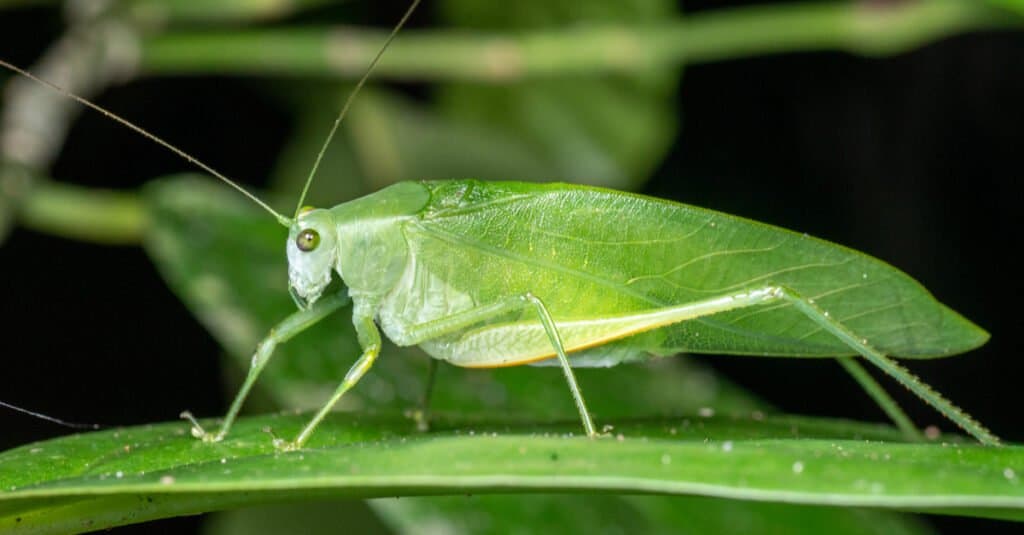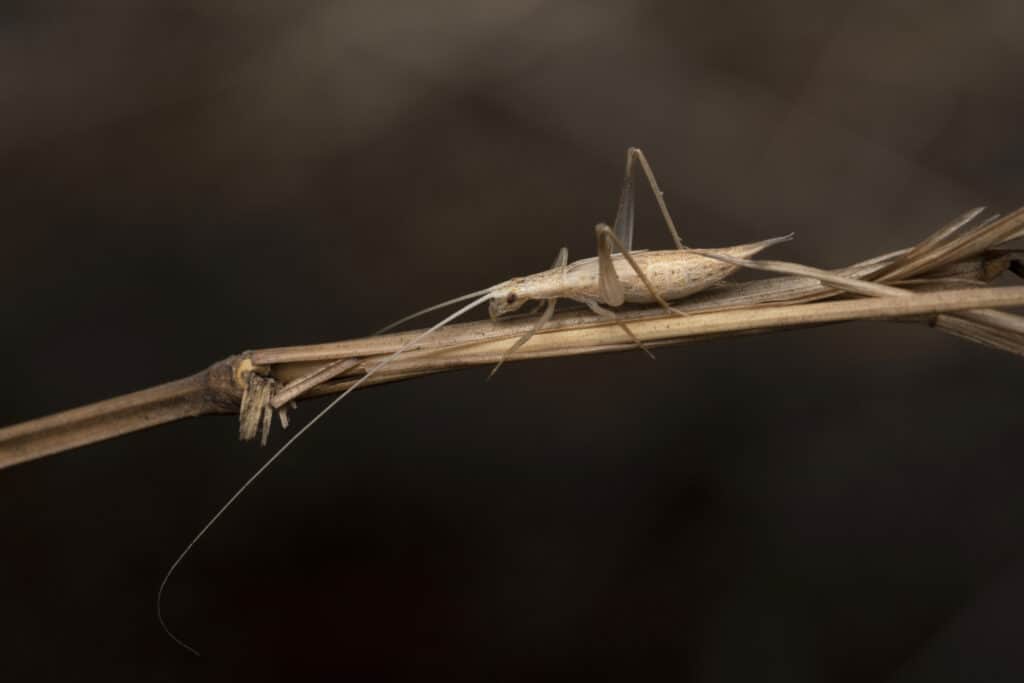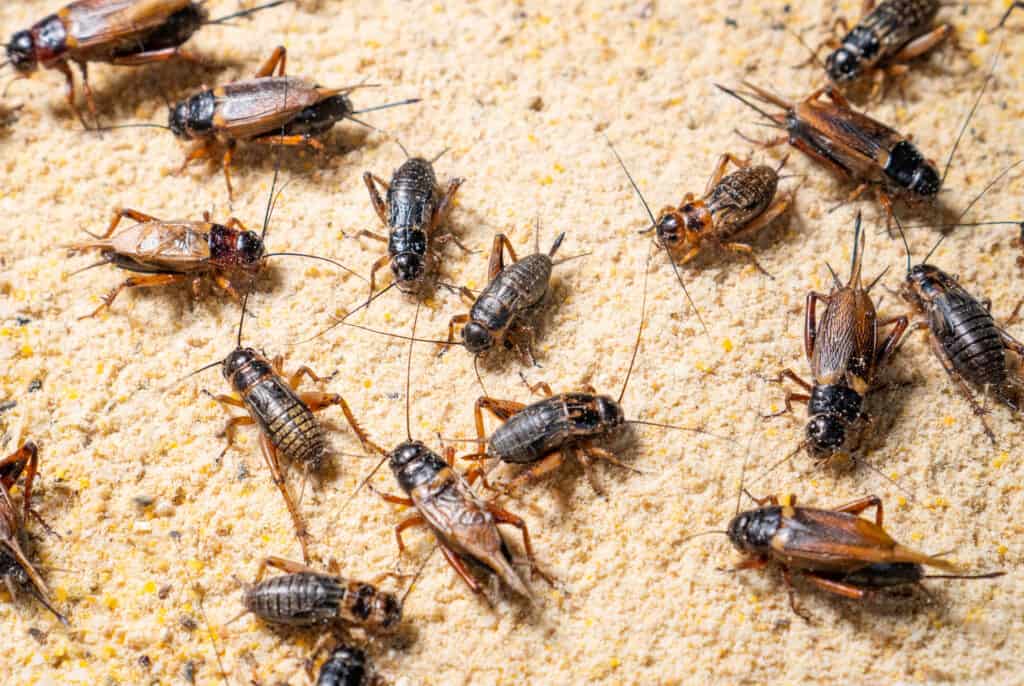
If you’re going camping, you’re certainly expecting to hear various bugs making sounds at night. You’ll probably even enjoy listening to them!
However, if you’re trying to get a good night’s sleep before a long day at work, the bugs singing around your house, most probably calling out females for mating, may get on your nerves. Even though establishing what insects emit the sounds you’re hearing won’t solve the problem, at least you’ll become familiar with their population. Who knows, maybe if you learn more about them, you’ll get accustomed to their calls faster!
1. Katydids

Katydids produce sounds by stridulation, meaning by rubbing two body parts together.
©Peter Yeeles/Shutterstock.com
| Katydids | |
|---|---|
| Scientific classification | Tettigoniidae (family) |
| Distribution | Worldwide, except in Antarctica. Most katydids live in the world’s tropical regions; they are abundant in the Amazon basin rainforest. |
| Unique feature | Leaf-like appearance |
| Sounds | They are capable of producing very loud sounds through stridulation. |
Katydids are part of the Tettigoniidae family of insects. Their common name and scientific name point to the sounds they make, as they’re considered onomatopoeic words. The name “katydid” points to the insects’ three-pulsed song – “ka-ty-did.” Some species emit sounds similar to “katy-did, katy didn’t.” Katydids produce sounds by stridulation, meaning by rubbing two body parts together. Some katydids can sing so loud that listening to them from close distances can become unbearable.
These insects can be either very small, measuring around 0.2 inches long, or pretty large, reaching 5.1 inches. However, small species are considered more agile and faster. Katydids live in trees. They’re nocturnal insects, which is why the sounds you hear at night may come from them.
Tettigoniids are famous for their leaf-like appearance, and their bodies even imitate the veins you see on leaves! However, not all 8,000 katydid species are green, and not all feature leaf-like appearances.
2. Tree Crickets

Tree crickets live in shrubs and trees.
©iStock.com/ePhotocorp
| Tree Crickets | |
|---|---|
| Scientific classification | Oecanthinae (subfamily) |
| Distribution | Worldwide, except in Antarctica |
| Unique feature | Can create a “megaphone” by using tree leaves to amplify their calls |
| Sounds | Emit long chirping (trilling) sounds |
Tree crickets are small insects with two pairs of wings. They have long, skinny bodies whose color adapts to their habitat, meaning they’re great at camouflaging. Moreover, tree crickets are excellent jumpers thanks to their large, powerful legs! They are also sensitive to touch and odor due to the antennae on their heads.
Tree crickets live in shrubs and trees. They’re nocturnal insects and feed on plant matter. Male tree crickets communicate by rubbing the ridges of their wings together. They emit long chirping sounds and sometimes continue chirping for a long period. Female crickets cannot produce calling sounds.
Besides disturbing you at night, tree cricket sounds play an essential role in mating. Males have a special mating call produced at specific frequencies. If the male tree cricket cannot produce loud sounds, they use tree leaves to create a “megaphone” structure, thus amplifying their mating calls.
The females, in turn, have hearing organs that help them pick up a wide range of frequencies – in fact, they are among the only insects that can receive such a range of frequencies! It is believed that females often choose calls at a lower range of frequencies because they are emitted by larger males, which may produce a greater amount of sperm.
3. Field Crickets

Field crickets are 0.59 – 1.22 inches long and have dark bodies.
©iStock.com/amnat jomjun
| Field Crickets | |
|---|---|
| Scientific classification | Gryllus (genus) |
| Distribution | Worldwide. They inhabit meadows, fields, and pastures |
| Unique feature | They have large hind legs that they use for jumping |
| Sounds | Pulsed chirping sounds emitted at intervals of around one second. |
Field crickets form the Gryllus genus. They’re 0.59 – 1.22 inches long and have dark bodies. With long antennae and multiple legs, field crickets make for very unpleasant-looking bugs! Besides this, they’re loud singers and can easily disturb your sleep at night.
While it highly depends on the species, field crickets generally prefer dry, sunny locations, where they live in meadows, fields, and pastures. Some field crickets can fly, while others are flightless, even if they possess wings.
A study on field cricket wing dimorphism shows that this depends on their wings’ length. Field crickets with long wings can fly, while those with short wings are flightless.
Most species emit a short, pulsed chirp produced at intervals of approximately one second. However, to the untrained ear, their calls will sound uninterrupted. Like other insects, tree crickets use a calling song to attract females. They also produce “courtship songs” and “rivalry songs.”
4. Cicadas

Cicadas form the
Cicadoideasuperfamily of insects.
©Georgi Baird/Shutterstock.com
| Cicadas | |
|---|---|
| Scientific classification | Cicadoidea (superfamily) |
| Distribution | 3,000 species distributed worldwide, living primarily in tropical areas with deciduous trees |
| Unique features | Unique wings that repel water and kill bacteria; prominent eyes; males can deactivate their “ears” while singing. |
| Sounds | Buzzing sounds, high-pitched whines, and rhythmic ticks |
Cicadas form the Cicadoidea superfamily of insects. They can be distinguished by their large, prominent eyes, short antennae, unique, membranous front wings, and the three small ocelli on top of their heads. Their beautiful wings can be hyaline (having a glassy appearance), pigmented, or cloudy. The forewings have a superhydrophobic coating, meaning they can repel water. Besides, their wings are the only known biomaterial to kill bacteria because the nanoscale-sized spikes on the wings tear the bacteria apart.
Another unique cicada ability is thermoregulation. Desert cicadas are among the only insects in the world that can use evaporative cooling to control their body temperature. Most cicadas are around 1-2 inches long. The largest species, called the empress cicada, or Megapomponia imperatoria, measures 2.8 inches long and has a 7-8 inches wingspan.
Besides all the unique characteristics listed above, cicadas have distinctive songs. They can produce buzzing sounds, rhythmic ticks, and high-pitched whines. Most species produce the sounds using the tymbal, a corrugated exoskeletal structure located on their anterior abdominal region.
While only males can produce sounds, both sexes have tympana that help them detect the songs. When the males emit sounds, they deactivate their tympana to avoid damaging their “ears.”
Summary of The 4 Loudest Bugs That Make Noise At Night
Here is a summary of the four loudest bugs that make noise at night:
| Rank | Bugs |
|---|---|
| 1 | Katydids |
| 2 | Tree Crickets |
| 3 | Field Crickets |
| 4 | Cicadas |
Bonus Bugs: The Loudest Insects

Bees flap their wings a staggering 230 per second!
©Alexandrum79/iStock via Getty Images
There are a few well-known bugs that are remembered for their loud night noises, however, there are other insects that can be just as loud at different times of the day or season.
Here are some of the loudest insects:
- Bees
- Desert Locust
- Water Boatmen
- Longhorned Beetles
The buzzing sound we often associate with bees primarily results from their rapid wing beats. Certain bees can astonishingly flap their wings up to 230 times per second, creating a significant buzz.
While cicadas are famous for their unmistakable loud calls, the Desert Locusts can generate immense sound by rubbing their wings or bodies, but it doesn’t match the distinctive noise of cicadas.
Additionally, water boatmen, measuring about three-quarters of an inch in size, swim upside down using two elongated legs resembling oar paddles. These creatures generate a remarkable 99.2 decibels of noise, akin to the experience of listening to a loudly playing orchestra from the front row!
Further, longhorned beetles frequently possess antennae that are equal to or even longer than their cylinder-shaped bodies. They produce squeaking sounds by scraping ridges on their head against their thorax.
The photo featured at the top of this post is © SIMON SHIM/Shutterstock.com
Sources
- Insectlopedia, Available here: http://insectlopedia.com/night-time-noisemakers-singing-insects/
- Wikipedia, Available here: https://en.wikipedia.org/wiki/Cicada
- Wikipedia, Available here: https://en.wikipedia.org/wiki/Gryllus_bimaculatus
- Southern Living, Available here: https://www.southernliving.com/garden/pests/cicada-sound
Thank you for reading! Have some feedback for us? Contact the AZ Animals editorial team.






